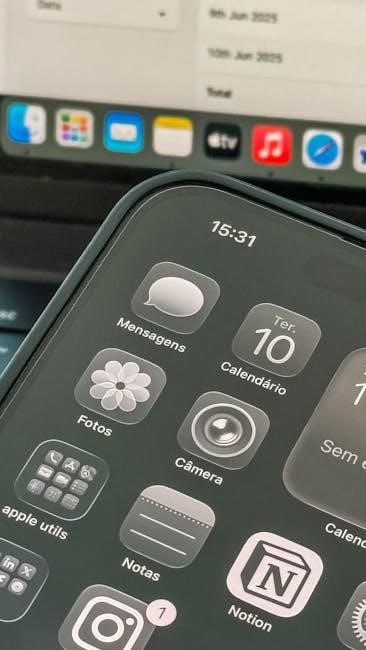BIRP Notes offer a structured method for clinical documentation, focusing on Behavior, Intervention, Response, and Plan. Widely used in mental health, they enhance treatment planning and client progress tracking effectively.
What Are BIRP Notes?
BIRP Notes are a structured method of clinical documentation used primarily in mental health settings. The acronym BIRP stands for Behavior, Intervention, Response, and Plan, representing the four key sections of the notes.
In the Behavior section, clinicians document objective observations of the client’s actions, mood, and engagement during the session. The Intervention section outlines the strategies or techniques the therapist used to address the client’s issues. The Response section captures how the client reacted to these interventions, providing insights into what strategies are effective. Finally, the Plan section details the next steps, including goals, homework, or referrals.
BIRP Notes are valued for their clarity and focus on the therapeutic relationship. They are particularly useful for tracking client progress and ensuring continuity in treatment plans. With ready-to-use PDF templates available, BIRP Notes offer a practical and efficient way to maintain accurate and organized clinical records.
Importance of BIRP Notes in Clinical Documentation
BIRP Notes play a crucial role in clinical documentation by providing a structured and standardized method for recording client interactions and treatment progress. They ensure clarity and consistency in documentation, making it easier for healthcare providers to communicate effectively and maintain continuity of care.
The structured format of BIRP Notes helps professionals track client behavior, interventions, and responses over time, enabling better decision-making and treatment planning. They also serve as a reliable reference for future sessions, ensuring that interventions are tailored to the client’s needs and progress.
Additionally, BIRP Notes promote accountability and compliance with professional standards. They provide a clear and organized record of sessions, which can be essential for legal purposes, insurance claims, and audits. By focusing on the therapeutic relationship and client responses, BIRP Notes enhance the quality of care and improve client outcomes. Their efficiency also reduces documentation time, allowing professionals to focus more on patient care. Overall, BIRP Notes are a valuable tool for mental health professionals seeking to deliver effective and documented treatment plans.

Structure of BIRP Notes
BIRP Notes are organized into four clear sections: Behavior, Intervention, Response, and Plan. Each section provides a structured approach to documenting client interactions, ensuring comprehensive and organized clinical documentation for mental health professionals.
Behavior (B)
The “B” in BIRP stands for Behavior, focusing on objective observations of the client during sessions. This section documents the client’s appearance, mood, affect, and engagement, as well as any subjective reports they provide. For example, noting a client’s minimal eye contact or flat tone offers insights into their emotional state. This section is crucial for tracking changes in behavior over time, which informs treatment planning and interventions. By capturing both observable and reported behaviors, the Behavior section provides a clear snapshot of the client’s current mental state, aiding in consistent and accurate documentation. This foundational information helps mental health professionals understand the client’s needs and responses to therapeutic interventions, ensuring a client-centered approach in care delivery. Effective documentation in this section supports continuity of care and serves as a reference for future sessions.
Intervention (I)
The “I” in BIRP stands for Intervention, detailing the actions taken by the mental health professional during the session. This section outlines specific therapeutic techniques, strategies, or activities used to address the client’s behavior or reported concerns. For instance, interventions might include cognitive-behavioral exercises, psychoeducation, or stress management techniques. The intervention section should clearly describe the approach used, such as “the therapist modeled coping skills” or “psychoeducation on mindfulness practices was provided.” This part of the note helps document the therapist’s active role in the session and ensures accountability. By specifying interventions, professionals can track the effectiveness of their methods and make informed decisions for future sessions. This section also serves as a reference for consistency in treatment plans and collaboration with other healthcare providers. Accurate documentation of interventions is essential for maintaining clear communication and continuity of care.
Response (R)
The “R” in BIRP stands for Response, capturing the client’s reaction to the interventions implemented during the session. This section documents how the client responded to the therapist’s techniques, providing insights into what strategies were effective or ineffective. For example, the client may have shown improved engagement or expressed feelings of relief after a particular intervention. The response section should include both verbal and non-verbal cues, such as “the client appeared more engaged” or “reported feeling hopeful about the future.” This part of the note is crucial for understanding the client’s progress and guiding future interventions. By detailing the client’s response, therapists can adjust their approach to better meet the client’s needs. This section also serves as a benchmark for measuring the client’s growth over time. Accurate documentation of responses ensures a clear and comprehensive record of the therapeutic process.
Plan (P)
The “P” in BIRP stands for Plan, outlining the next steps in the client’s treatment. This section details actionable goals, interventions, and strategies for future sessions. It may include specific tasks for the client, such as homework assignments or behavioral exercises, to support their progress. The plan should align with the client’s treatment goals and address any concerns or risks identified during the session. For example, the therapist might schedule a follow-up appointment, refer the client to a specialist, or assign coping techniques to practice. The plan should be clear, measurable, and tailored to the client’s needs. It also serves as a roadmap for both the therapist and client, ensuring continuity of care. Documenting the plan helps track progress over time and provides a clear direction for upcoming sessions. This section is essential for maintaining a structured and goal-oriented approach to therapy. By outlining the next steps, the plan ensures that the client’s care remains focused and effective.

BIRP Notes Templates
BIRP notes templates provide structured formats for documenting client sessions. Available in PDF and DOCX, they offer pre-designed sections for Behavior, Intervention, Response, and Plan, ensuring organized and professional clinical documentation.
PDF Templates for BIRP Notes
PDF templates for BIRP notes are widely used for their professional and organized structure, making clinical documentation efficient. These templates are easily downloadable and printable, allowing therapists to fill them out during or after sessions. The PDF format ensures that the layout remains consistent, providing a clear and readable design. Many mental health professionals prefer PDF templates because they can be securely stored in patient records, adhering to HIPAA guidelines. Additionally, PDF templates are ideal for practices that prefer paper-based documentation or need a backup for digital systems. They are often available for free or purchase on mental health websites, offering a convenient solution for standardized note-taking. By using BIRP note PDF templates, clinicians can maintain professionalism and consistency in their documentation while saving time during sessions.
Customizable BIRP Notes Templates
Customizable BIRP notes templates provide flexibility for mental health professionals to tailor documentation to their specific needs. Available in formats like DOCX, these templates can be edited directly in Microsoft Word, allowing practitioners to add or modify sections based on their practice requirements. Clinicians can input client-specific details, treatment plans, and session outcomes, ensuring each note is personalized and comprehensive. These templates often include prompts for each section—Behavior, Intervention, Response, and Plan—guiding the documentation process. The ability to customize enhances the clarity and relevance of notes, making them more effective for tracking client progress and informing future sessions. Additionally, customizable templates can be adapted to fit various therapeutic approaches or specialties, ensuring versatility across different clinical settings. By offering a balance between structure and flexibility, customizable BIRP notes templates support efficient and individualized documentation, benefiting both practitioners and clients alike;
How to Use BIRP Notes Templates
Using BIRP notes templates is a straightforward process that streamlines clinical documentation. Begin by downloading the template in your preferred format, such as PDF or DOCX. For PDF templates, print the document and fill it out manually during or after the session. For DOCX templates, open the file in Microsoft Word and input client information directly. Ensure all four sections—Behavior, Intervention, Response, and Plan—are completed with relevant details.
- Document objective observations of the client’s behavior and mood under the Behavior section.
- Outline the interventions or strategies used during the session in the Intervention section.
- Record the client’s responses to these interventions in the Response section.
- Detail the plan for future sessions, including actionable steps or referrals, in the Plan section.
After completing the template, save the file securely, ensuring compliance with HIPAA guidelines. Regularly review and update templates to reflect evolving client needs or practice requirements. This method ensures efficient, organized, and professional documentation of client progress.

Creating Effective BIRP Notes
Creating effective BIRP notes involves capturing clear observations in each section—Behavior, Intervention, Response, and Plan. This structured approach ensures comprehensive documentation, aiding treatment planning and continuity of care for mental health professionals.
Steps to Write BIRP Notes
Writing effective BIRP notes involves a systematic approach to ensure clarity and completeness. Start by documenting the client’s Behavior, including objective observations like mood, affect, and engagement. Next, outline the Intervention strategies used, such as therapeutic techniques or educational resources provided. Then, capture the client’s Response to these interventions, noting verbal and non-verbal reactions. Finally, detail the Plan, including actionable steps, homework assignments, and the next session’s focus. Ensure each section is concise and directly tied to the client’s treatment goals. Using a BIRP notes PDF template can streamline this process, ensuring consistency and professionalism. Always sign, date, and securely store the notes to maintain confidentiality and compliance with regulations. By following these steps, you can create accurate and effective BIRP notes that support client care and documentation needs.

Examples of BIRP Notes
Here’s an example of a BIRP note for a client with anxiety:
Behavior: Client appeared anxious, fidgeting, and avoided eye contact. Reported difficulty sleeping and feeling overwhelmed.
Intervention: Educated on deep-breathing exercises and cognitive restructuring. Provided coping strategies for managing anxiety.
Response: Client expressed relief after practicing breathing techniques and showed interest in continuing exercises at home.
Plan: Assign homework to practice deep-breathing daily. Schedule follow-up session to review progress. Refer to a support group for additional resources.
Another example for a client with depression:
Behavior: Client presented with a flat affect, spoke in a low tone, and reported feelings of hopelessness.
Intervention: Discussed behavioral activation and explored barriers to engagement.
Response: Client acknowledged understanding of strategies but expressed doubts about effectiveness.
Plan: Develop a safety plan and schedule a phone check-in. Refer to a psychiatrist for medication evaluation.
These examples demonstrate how BIRP notes clearly document client progress and treatment plans. Using a BIRP notes PDF template ensures consistency and professionalism in your documentation.
Tips for Writing BIRP Notes

To write effective BIRP notes, focus on clarity and conciseness. Ensure each section (Behavior, Intervention, Response, Plan) is distinct and directly tied to the session’s objectives. Use specific examples to document observable behaviors and client responses, avoiding vague statements. Maintain a client-centered approach, highlighting strengths and challenges. Regularly review and update notes to reflect progress and adjustments in treatment plans. Use a BIRP notes PDF template to streamline the process and ensure consistency. Always include dates, signatures, and client identifiers for accountability. Store notes securely to comply with HIPAA standards. Finally, keep the language professional yet accessible, avoiding unnecessary jargon. By following these tips, you can create clear, effective BIRP notes that enhance client care and documentation accuracy.


BIRP Notes vs. SOAP Notes
BIRP and SOAP notes are both structured documentation methods. BIRP focuses on Behavior, Intervention, Response, Plan, while SOAP covers Subjective, Objective, Assessment, Plan. Each serves distinct clinical needs, with BIRP emphasizing therapeutic interactions and SOAP prioritizing medical assessments.
Key Differences Between BIRP and SOAP Notes
The primary distinction lies in their focus and structure. BIRP notes emphasize the therapeutic relationship, documenting Behavior, Intervention, Response, and Plan, making them ideal for mental health professionals to track client progress and treatment plans.
SOAP notes, however, are more medically oriented, focusing on Subjective patient reports, Objective data, Assessment of conditions, and Plan for treatment. Unlike BIRP, SOAP includes a diagnostic assessment section, aligning with medical settings requiring detailed patient evaluations.
While both formats include a plan section, BIRP’s structure is tailored for therapy sessions, highlighting client responses to interventions, whereas SOAP is broader, covering symptoms, test results, and diagnoses. This makes BIRP more client-centered and SOAP more clinically comprehensive.
When to Use BIRP vs. SOAP Notes

The choice between BIRP and SOAP notes depends on the clinical setting and documentation needs. BIRP notes are ideal for mental health professionals, particularly in therapy sessions, as they focus on the therapeutic relationship, client responses, and treatment planning. They are well-suited for tracking progress in counseling or psychotherapy, where the emphasis is on interventions and client reactions.
SOAP notes, on the other hand, are more appropriate for medical settings requiring detailed patient evaluations, diagnoses, and treatment plans. They are commonly used in hospitals, clinics, and primary care, where objective data, symptoms, and assessments are critical. SOAP notes are preferred when there is a need to document subjective patient reports, objective findings, and clinical diagnoses.

Benefits of Using BIRP Notes
BIRP notes enhance clinical documentation by providing a clear, structured format. They improve communication among healthcare providers, ensure consistency, and support accurate tracking of client progress, making them a valuable tool for mental health professionals.
Advantages of BIRP Notes in Mental Health Documentation
BIRP notes provide a clear and concise framework for mental health documentation, ensuring consistency and professionalism. They focus on the therapist-client relationship, detailing interventions and client responses, which helps tailor treatment plans effectively. By organizing information into four distinct sections—Behavior, Intervention, Response, and Plan—BIRP notes streamline documentation, reducing time spent on note-taking; This allows mental health professionals to allocate more time to client care. Additionally, BIRP notes improve accountability and transparency, as they clearly outline the client’s progress and future steps. They are also beneficial for billing purposes and maintaining accurate client records. The structured format makes it easier to track client progress over time, enabling informed decision-making. Overall, BIRP notes are a practical and efficient tool for mental health professionals, enhancing both documentation quality and client outcomes.
How BIRP Notes Improve Client Care
BIRP notes enhance client care by providing a structured and organized approach to documentation, ensuring that all critical aspects of treatment are addressed systematically. The Behavior section captures objective observations of the client’s condition, enabling targeted interventions. By documenting specific interventions and the client’s responses, BIRP notes allow therapists to refine their strategies and tailor future sessions to the client’s needs. This focus on the client’s reactions helps identify what interventions are most effective, fostering personalized care. Additionally, the Plan section outlines clear next steps, ensuring continuity of care and setting measurable goals for future sessions. BIRP notes also improve communication among healthcare providers by providing a standardized format, reducing misunderstandings and ensuring cohesive treatment plans. Overall, BIRP notes promote accountability, transparency, and client-centered care, ultimately leading to better client outcomes and more efficient treatment processes.

